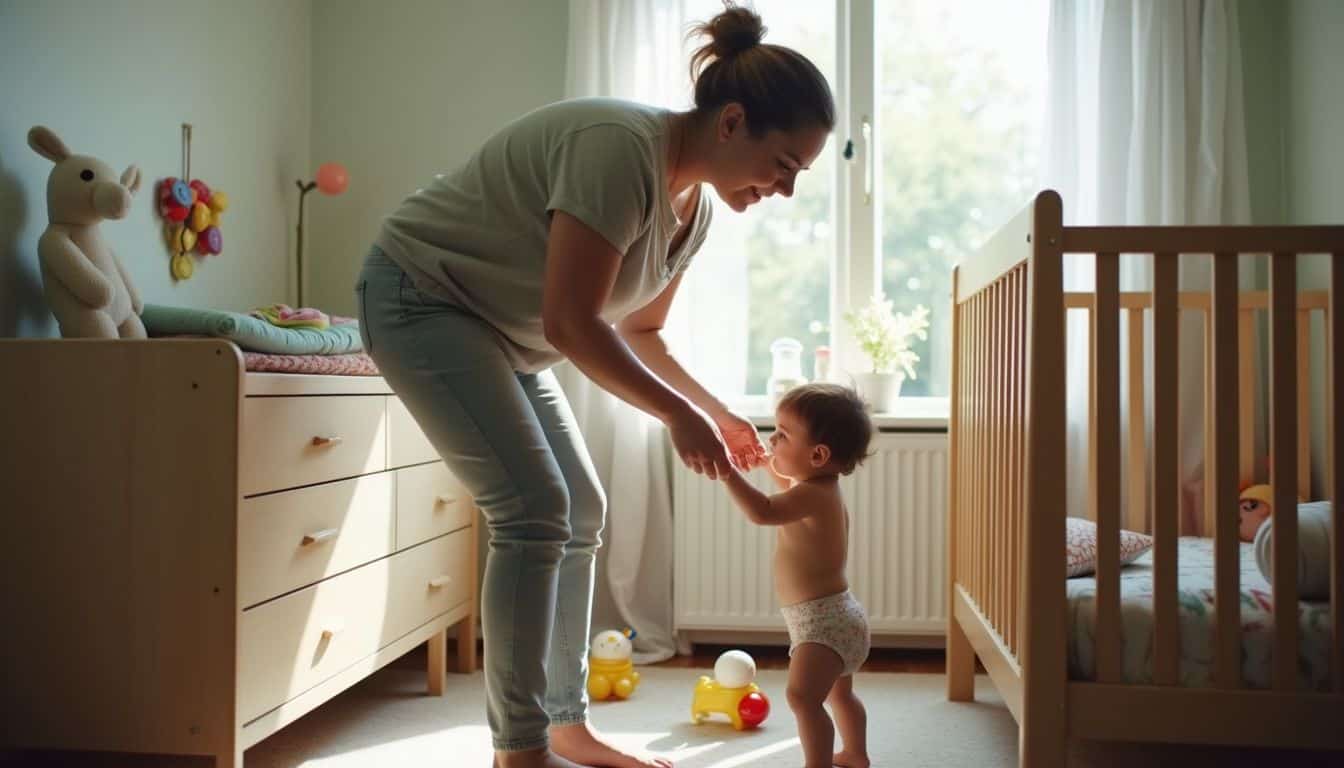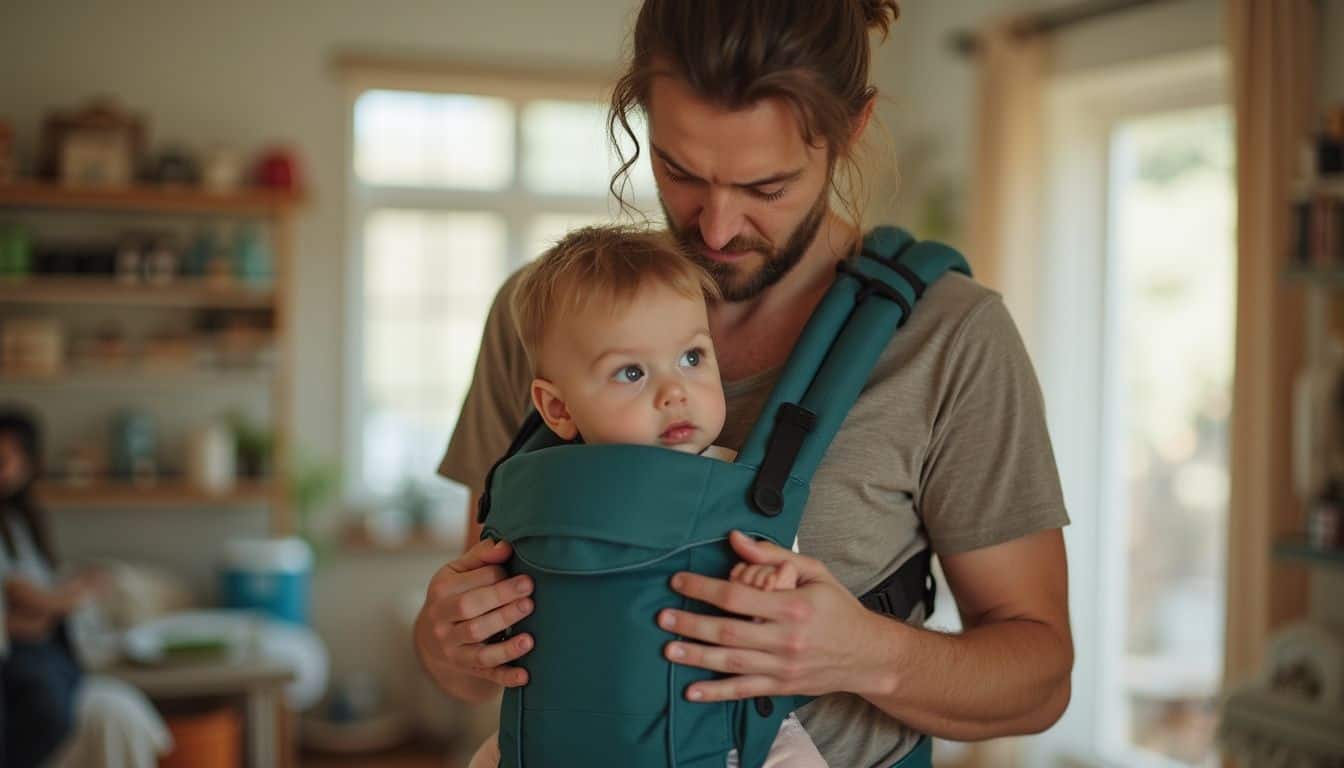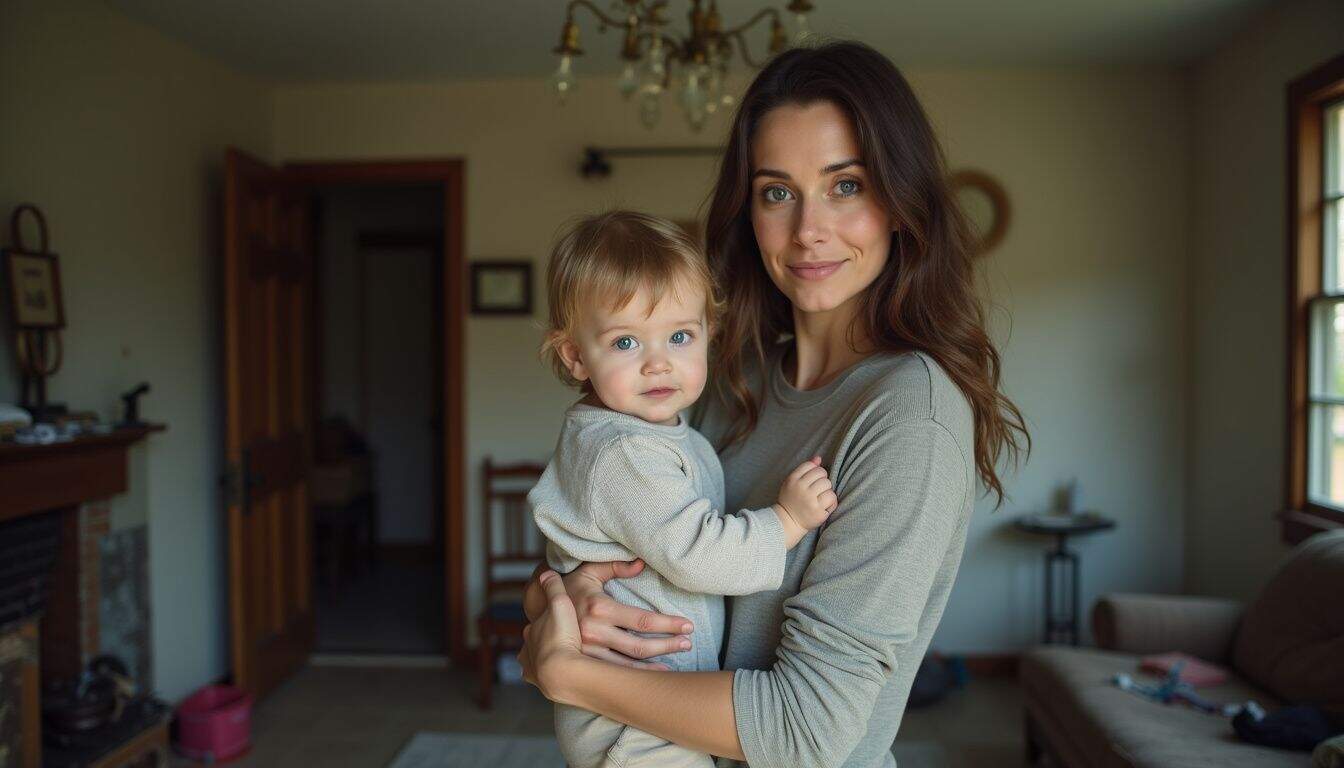Have you ever bent down to pick up your child and felt that familiar, dreaded twinge in your lower back?
If you’re nodding along, you are definitely not alone. A study from the University of Michigan found that over 70% of mothers experience postpartum back pain.
Lifting our kids the wrong way can strain everything from our necks to our spines, sometimes leading to serious issues like a herniated disc. But learning how to lift kids without hurting your back isn’t complicated.
I’m going to walk you through the simple, back-saving techniques that have helped me, both as a mom and during my shifts in nursing. Let’s get started!
Key Takeaways
Stable Stance First: Plant feet hip-width apart, toes forward; squat through knees, not waist, pushing heels to engage legs and protect spine.
Hold Close: Pull child tight to chest/belly button to minimize leverage and back strain—use carriers for longer hauls.
Power with Legs: Drive lift using glutes and thighs; keep back straight and core engaged like a natural corset.
No Twisting: Point toes in travel direction, pivot with feet—keep hips/shoulders aligned to avoid disc damage.
Smart Carrying: Alternate hips to prevent imbalances; limit prolonged hip holds, opt for ergonomic carriers over time.
Table of Contents
Safe Lifting Techniques

You want to be able to scoop up your child without feeling that sharp zing in your back, right?
Building these simple habits means you can focus on cuddles, not on reaching for muscle relaxants after lifting a toddler from the crib.
How should I position my feet when lifting my child?
Properly positioning your feet is the foundation of a safe lift. It gives you a stable base, which is crucial when you have a wriggling toddler in your arms.
Here are the key steps to remember:
- Create a Strong Base: Plant your feet about hip-width apart, just as experts like physical medicine specialist Tracy Espiritu McKay, DO, recommend. This widens your base of support.
- Point Toes Forward: Keep your toes pointed straight ahead. This helps you stay balanced if your child makes a sudden move.
- Align Your Body: Make sure your ankles, hips, and shoulders are stacked in a straight line. This engages your core muscles and takes the pressure off your sensitive lower back area.
- Push Through Your Heels: As you squat to lift, press your weight down through your heels. This action activates your powerful glute and thigh muscles, so they do the work instead of your back.
A great pro-tip from many physical therapists is to try a lunge stance, with one foot slightly in front of the other. This is especially helpful for lifting kids from a low spot, like out of the bathtub, because it provides even more stability.
According to Auragens, a research institute focused on spinal health, establishing a good stance protects your spinal discs from the wear and tear of bad habits.
Why bend your knees instead of your waist?
When you bend your knees into a squat, you shift the workload from your small, vulnerable back muscles to the powerhouses of your body: your thighs and hips.
Your leg muscles are designed to handle heavy loads, while your back is not. The Cleveland Clinic notes that bending at the waist can put up to 10 times more pressure on the discs in your spine.
That extra pressure is what leads to low back pain, sciatica flare-ups, and even a herniated disc. Squatting keeps your back straight, which protects the delicate facet joints and nerve roots in your spine.
In my experience, keeping my chest up while squatting to get my squirmy toddler made all the difference. It stopped feeling like a dangerous weightlifting competition during every diaper change.
Think of it this way: repeatedly bending at the waist is like stacking up tiny injuries over time, which can eventually lead to a bigger problem requiring physical therapy.
How do I keep my child close to my chest safely?
Holding your child close to your body is one of the most effective ways to protect your spine. As professor of orthopedic surgery Neel Anand, MD, explains, this simple action reduces the lever arm, which decreases the amount of force your back has to handle.
Think of it like carrying a heavy grocery bag. It feels much lighter when you hold it against your body versus with your arm extended, right? The same principle applies here.
To do it safely:
- Squat Down: Start by getting low with your knees bent and feet hip-width apart.
- Hug Them In: As you begin to lift, pull your child in towards your belly button. Physician Mara Vucich, DO, specifically recommends this to center their weight.
- Hold Them Snugly: Keep them tight against the middle of your chest. This engages your core and provides better support.
- Use a Carrier for Long Hauls: For longer periods, a soft wrap like a Moby Wrap or a structured baby carrier is a fantastic tool. It keeps the weight distributed evenly while freeing up your hands.
This is especially important as babies grow, often weighing between 15 and 30 pounds by their first birthday.
What is the best way to use leg muscles to lift?
To truly use your leg muscles, you need to think like you’re doing an exercise at the gym. Your legs are significantly stronger than your back, so let them do the heavy lifting.
First, plant your feet firmly and get into a low squat. Keep your straight back and chest up.
As you stand up, push powerfully through your heels. Imagine you are pushing the floor away from you. This motion fully engages your glutes and thighs, which are the largest muscles in your body. It takes the strain completely off your spine and the sensitive cauda equina nerves.
A great way to train these muscles is by practicing specific exercises. A physical therapist will often recommend bodyweight squats or goblet squats. Holding a weight close to your chest during a goblet squat perfectly mimics the motion of lifting a child.
Engaging your legs this way dramatically lowers your risk of sprains or the kind of sudden back pain that might have you looking up chiropractic manipulation on your phone.
How can I avoid twisting my torso while lifting?
Twisting while lifting is one of the most dangerous movements for your back. This combination of bending and rotating, what doctors call “flexion with rotation,” places immense pressure on your spinal discs and is a common cause of injury.
Here’s how to prevent it:
- Point Your Toes: Before you even start to lift, turn your feet so your toes are pointing in the direction you want to go. Your body will naturally follow your feet.
- Pivot, Don’t Twist: Once you’ve lifted your child, move your entire body by taking small steps with your feet. Spine experts like Peter G. Whang stress that this pivot motion protects your spine.
- Keep Hips and Shoulders Aligned: Imagine a straight line connecting your shoulders and your hips. Keep that line straight as you lift and move.
- Get Closer: When putting your child into a crib or car seat, get as close to it as possible. Avoid reaching or stretching awkwardly over the object.
A simple trick is to think, “point your belly button where you want to go.” This little mental cue ensures your whole torso moves as one unit, which can save you from a world of back pain.
Tips for Carrying Kids

Once your little one is up in your arms, a few smart strategies can keep you comfortable and pain-free.
From using a baby carrier to engaging the right muscles, these small changes can make a huge difference in your day.
How can alternating sides prevent muscle imbalance?
Do you always carry your child on the same hip? Most of us do without even thinking about it. But consistently carrying them on one side creates a muscle imbalance that can lead to chronic pain.
When you prop a child on one hip, your body has to compensate. One side of your back and core muscles becomes tight and overworked, while the other side can become weak. This can pull your spine out of alignment.
Physical therapy experts warn that this habit can contribute to issues like sacroiliac joint dysfunction or IT band syndrome over time.
The fix is simple: switch sides often. Think of it like carrying grocery bags. You wouldn’t carry them all in one hand, so apply the same logic here. This simple habit helps keep your posture in check and can save you from future trips for rehabilitation.
Why should I engage my core when carrying my child?
Think of your core muscles as a natural corset that supports and stabilizes your spine. When you tighten these muscles before you lift or while you carry, you give your back critical protection.
As physical therapist Rachelle Thomas, PT, DPT, recommends, engaging your core is key to avoiding muscle strains.
A strong core makes it easier to maintain good posture while you’re juggling a diaper bag, a wriggling child, and maybe even a car seat. To engage your core, gently tighten your stomach muscles, as if you’re about to brace for a playful poke in the belly.
An excellent exercise to practice this is the “dead bug.” It teaches your body how to keep your core stable while your arms and legs are moving, which is exactly what happens when you’re carrying your child.
This stability is what protects your lower back from the stress of everyday parenting tasks.
When should I use baby carriers or hip seats?
Carrying a 20-pound toddler on your hip can get tiring, fast. That’s where baby carriers and hip seats become absolute lifesavers. They are designed to distribute your child’s weight more evenly across your body.
Structured carriers with wide, padded straps are ideal for longer outings like a walk in the park or a trip to the zoo. They spread the weight across your shoulders and hips, allowing you to be hands-free.
Hip seats are perfect for toddlers who are in that “up-down” phase. They provide a supportive perch for quick carries, like running errands or navigating a busy airport. They take the strain off your arms and back for those short but frequent lifts.
Here is a quick comparison of two popular options:
| Feature | Structured Carrier (e.g., Ergobaby Omni 360) | Hip Seat (e.g., Tushbaby) |
|---|---|---|
| Best For | Hands-free carrying, long walks | Quick ups-and-downs, older toddlers |
| Weight Distribution | Across both shoulders and hips | Primarily on the hips and core |
| Supports up to | 45 lbs | 45 lbs |
| Babylist User Rating | 4.8 / 5 Stars | 4.7 / 5 Stars |
These tools can be a game-changer, especially on days when you feel like you’re doing it all on your own. As I’ve written about before, being ready for single motherhood sometimes means finding the right gear to help you out.
Why is prolonged hip carrying harmful?
That classic mom-on-the-hip pose might be convenient, but holding it for long periods can cause real problems. When you jut one hip out to support your child, you’re forcing your spine into an unnatural curve.
This lopsided posture puts a lot of strain on the muscles and ligaments in your lower back, hips, and even your neck and shoulders. Over time, this can lead to chronic pain and muscle imbalances.
Experts like Dr. Whang urge parents to limit this type of carrying because the repeated strain can trigger nagging soreness that just doesn’t seem to go away. In some cases, it can even irritate nerves, like the one that causes a tingling or numb sensation in your outer thigh, a condition called meralgia paresthetica.
Your child’s weight only increases, tipping the scales at 30 pounds or more as a toddler. The best strategy is to be mindful, switch sides frequently, and rely on carriers or strollers for longer journeys.
How Will Safe Lifting Techniques Change in 2025?

As we look ahead, the focus on parental well-being is only getting stronger. In 2025, we can expect to see even smarter and more accessible ways to protect our backs.
I tweaked my own back during a middle-of-the-night diaper change once, so I know how needed this support is.
Telehealth physical therapy will likely become more common, with platforms like Hinge Health offering personalized exercise programs for parents right on their phones. We’ll also see more advice about injury prevention integrated into parenting apps like The Bump.
Baby gear will continue to evolve, too. Designers are focusing more on ergonomics, with an emphasis on lightweight, breathable materials. We’re already seeing this with carriers like the BabyBjörn Harmony, and this trend is expected to grow. You might even see special deals on ergonomic gear pop up on Target baby registries.
The goal is to make safe lifting feel second nature, with clear, simple instructions available right where you need them most.
People Also Ask
What is the safest way to lift kids without hurting your back?
Always bend from your knees and hips, keeping your back straight in a neutral position. Engage your deep core muscles by pulling your belly button toward your spine as you lift your child close to your chest.
Are there quick tips for parents who lift children often?
Avoid twisting your body while lifting, and try to alternate which hip you use for carrying to prevent muscle imbalances. For toddlers, using an ergonomic carrier can distribute their weight evenly and save your back.
How do I avoid back pain after a long day of lifting my toddler?
Perform gentle stretches like the cat-cow or a pelvic tilt for a few minutes each day to release tension in your lower back. These simple movements help realign your pelvis and keep your muscles from getting too tight.
Can certain habits make lifting safer over time?
Yes, building core strength through activities like Pilates or yoga is one of the best long-term habits for protecting your back.
